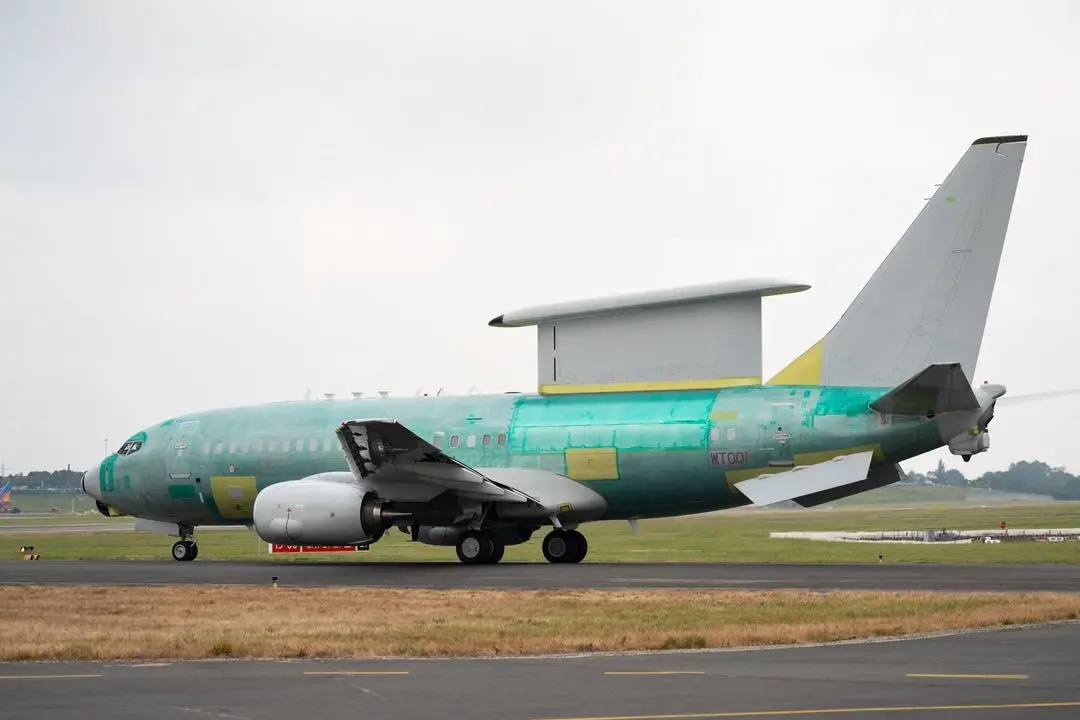The Royal Air Force (RAF) Wedgetail E7 AEW Mk1 aircraft has taken its maiden test flight from Birmingham Airport in the UK. This marks an important milestone in the delivery of this cutting-edge Airborne Early Warning and Control capability (AEW&C). Currently unpainted, the aircraft undertook what is known as a Functional Check flight, which tests flying control, engine, and avionics systems following the initial build phase, which took place at STS Aviation Services, Birmingham. The Wedgetail is the most technologically advanced AEW&C system available and will provide UK Defence with eyes in the sky, to see far beyond ground-based systems and fighter aircraft sensors. Already in service and proven with the Royal Australian, Republic of South Korean and Turkish Air Forces, the platform has recently been selected by the United States Air Force and NATO as their next command and control aircraft.
“This safe and systematic Functional Check Flight is an important step for Boeing and the RAF as part of our rigorous and extensive testing and evaluation. Our team is committed to ensuring the E-7 delivers the safety, quality, and capabilities we’ve promised to our customer as we prepare for delivery of the UK’s first E-7 Wedgetail to the RAF,” Stu Voboril, Boeing Vice President and E-7 Program Manager said.
“Achieving the first flight of Wedgetail is a significant milestone, representing an outstanding effort from the RAF programme team, Defence Equipment & Support (DE&S), Boeing, and STS Aviation Services. We will now build on this success and look forward to continuing the Test & Evaluation phase as part of our preparations for the aircraft to enter service with the RAF,” Group Captain Richard Osselton, RAF Programme Director for Wedgetail said.

The Boeing E-7 Wedgetail, also marketed as the Boeing 737 AEW&C, is a twin-engine airborne early warning and control aircraft based on the Boeing 737 Next Generation design. The E-7 was designed for the Royal Australian Air Force (RAAF) under “Project Wedgetail” and designated E-7A Wedgetail. Capable of generating a 360-degree view of the airspace and as a force multiplier, it will provide advanced warning of approaching threats to enable commanders to fight effectively in complex environments. Capable of fulfilling a wide range of missions, Wedgetail will provide high fidelity and accurate target information utilising its cutting-edge Multirole Electronically Scanned Array housed in a distinctive fin on the spine of the aircraft. The sensor, combined with an advanced communications suite, enables the crew to provide tactical control to other assets via voice and tactical data link whilst enhancing the situational awareness of Joint Force commanders.
The mission crew will utilise state-of-the-art workstations to deliver a multi-domain battle management capability: providing situational awareness to other assets, directing offensive and defensive forces whilst maintaining continuous surveillance of an area. The Wedgetail significantly enhances the capability of friendly combat aircraft and warships, enabling their missions and increasing their survivability in a hostile environment. Later this Autumn, the aircraft will depart to a paint facility to receive its RAF livery. The UK’s Wedgetail will serve under No 8 Squadron and will be located at RAF Lossiemouth alongside the Poseidon Maritime Patrol aircraft, both of which are based upon the widely used Boeing 737 Next Generation airframe, allowing the RAF to take advantage of synergies between the fleets.












